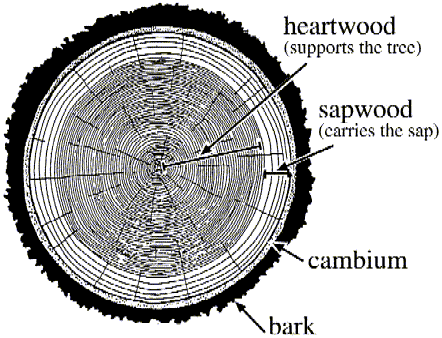How does a tree grow?
Grass grows from the roots up. You mow your lawn, and the growth zone,
located at the base of each blade of grass, grows upward. Then it's not long before the lawn needs cutting
again. It's a complete different story with trees. A tree trunk grows only in diameter; each part of the trunk
remains at the same height. Upward growth comes from the shoot at the end of each branch. Cut off the end of a branch and it
will start growing in a different direction, from the shoot located closest to where the branch was pruned.
The trunk and branch grow in diameter, The part that grows is a thin layer of cells under the bark, called the
cambium. The cambium grows inward, producing wood, and outward, producing bark.
When part of the cambium becomes damaged or torn, it stops growing in that spot and the surrounding tissues
form a scar.
In deciduous trees, the sap is carried up and down by vessels located in the outermost part of the tree,
the sapwood. This is the living part of the tree's wood. The entire centre of the tree, the heartwood, primarily
serves to support the tree.
 The bark plays an essential role, protecting the tree from damage caused by extreme temperatures, the sun's rays, insects, bacteria, people,
machines, etc.
The bark plays an essential role, protecting the tree from damage caused by extreme temperatures, the sun's rays, insects, bacteria, people,
machines, etc.
On the branches are the leaves which, thanks to photosynthesis, help the tree (and us!) to live.
Large branches grow directly from the trunk, while smaller ones come off the larger ones, and so on. They are so closely interconnected
that they can normally support quite a lot of weight.
However, the wood in the branches is quite different from that in the trunk.
A branch could even be thought as a foreign body from the trunk or another branch.
From the Horticultural Leaflet
published by the Montreal Botanical Garden "After the ice storm".
|